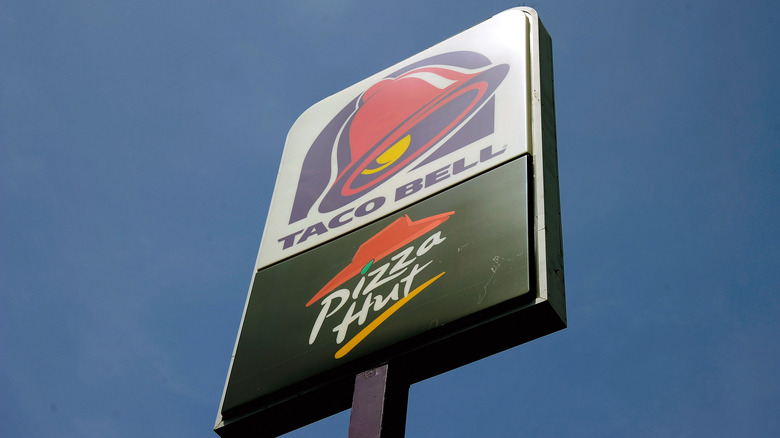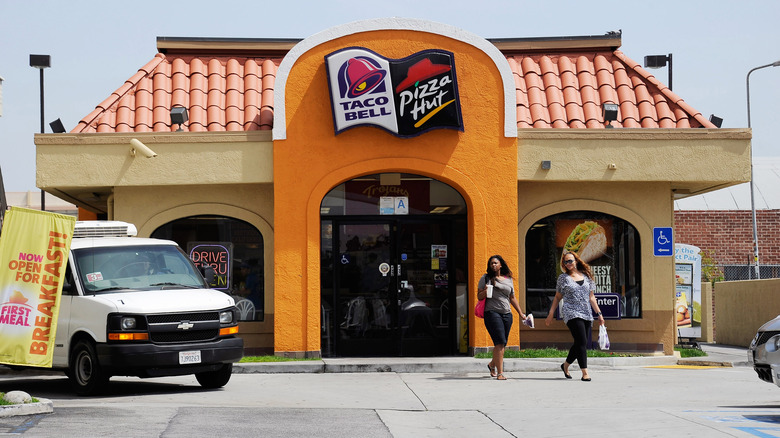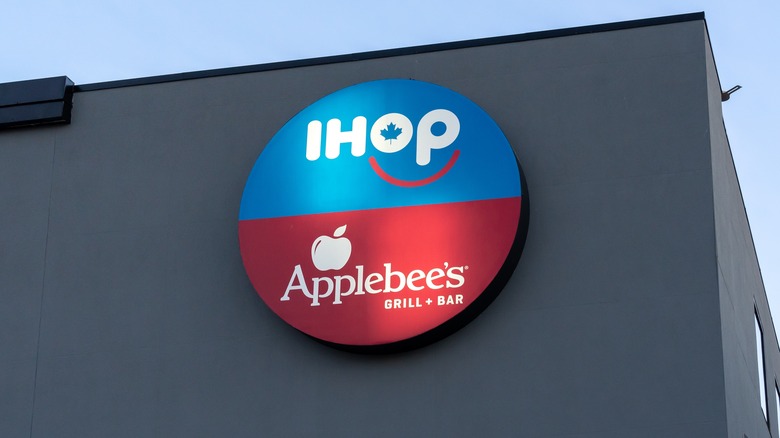Whatever Happened To Those Taco Bell/Pizza Hut Hybrid Restaurants?
Whenever you and your companion couldn't agree on where to eat, the combination of Taco Bell and Pizza Hut under one roof was there to save the day. This glorious mashup was possible because Taco Bell and Pizza Hut share the same corporate parent, Yum! Brands. However, the combination of these brands didn't last long, with most combo locations closed as of 2024.
Yum! pushed the narrative that the co-branded restaurants were intended to give diners more choices in one space, ostensibly helping Yum! to save money on real estate and enabling locations to share common restaurant equipment. However, it appears that all diners really wanted to do was make a run for the border; to this day, Taco Bell sales vastly outperform those of Pizza Hut. This could have made sharing space between the Hut and the Bell more of a liability than expected for Yum!. Indeed, Pizza Hut is even struggling against other national pizza brands, as Domino's is currently the US's biggest pizza chain.
These days, finding a combined Taco Bell/Pizza Hut location is rare. Yum! Brands never went on record with a rationale for breaking up the hybrids, but it quietly started closing locations, or converting them to single-chain units, in the 2010s.
The combination Taco Bell/Pizza Hut didn't last
With over 59,000 restaurants in its full portfolio, Yum! Brands is the biggest fast food operator in the world. Other Yum! chains include The Habit Burger Grill and KFC. The latter brand even resulted in a rarer triple restaurant combination jokingly called "KenTacoHut".
Yum! started opening combination Taco Bell/Pizza Hut locations in the early 2000s to compete with McDonald's, according to a report by RetailWire. Then-CEO of Yum!, David Novak, noted in a 2002 annual report that "McDonald's has something for everybody, and this drives sales." Indeed, Yum! had the power to combine pizza and fast Mexican under one roof, while McDonald's couldn't. However, the business reality wasn't so simple.
Rumors spread rampantly that the combo restaurants were cutting quality corners to save a buck — a perception that wasn't helped when the New York Department of Health shut down the Penn Station TacoHut for multiple violations in 2012 and 2013. Redditors have also noted that some of the hybrid locations only ever offered limited Pizza Hut options — and were sometimes even out of pizza. Perhaps this signaled that Yum! provided more resources for the more profitable Taco Bell side of the business.
Taco Bell currently outperforms KFC and Pizza Hut, notching a 5% sales increase in the most recent quarter while the others faltered. In early 2024, Yum! announced plans to open at least 100,000 more restaurants worldwide (across all four of its brands), including a significant Taco Bell international expansion.
New fast food hybrid locations are on the rise
Despite the quiet retirement of Taco Bell/Pizza Hut hybrids, as other restaurant groups take on more brands, dual restaurant locations are making a comeback.
Dine Brands, the parent company of IHOP and Applebee's, successfully launched hybrid locations of these two restaurants in Canada and other countries. Dine aims to build on that momentum, announcing in early 2024 plans to expand the concept to the United States. Dine sees combo IHOP and Applebee's locations as a way to corner the family sit-down market from breakfast through dinner.
FAT Brands, the parent company of Fatburger, has a staggering 16 brands in its portfolio, including Fazoli's, Marble Slab Creamery, and Johnny Rockets. Originally operating Fatburger/Buffalo's Express hybrids, FAT Brands opened its first triple restaurant location in late 2022, which adds Hot Dog on a Stick to the established duo.
It's noteworthy that Yum! Brands never fully exited the chain combo game. WingStreet chicken restaurants are only found alongside Pizza Hut locations; in fact, an attempt at a standalone WingStreet in Denton, TX failed within months of opening in 2003.


